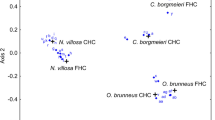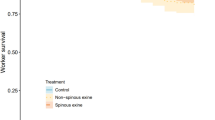Abstract
The response of Cycloneda limbifer Say (Coleoptera: Coccinellidae) larvae to conspecific larval tracks was investigated with the assistance of the automatic video tracking system EthoVision. Single larvae were monitored for 1 h in an arena with a choice of two substrates, one clean and one contaminated with the tracks of conspecific larvae. Fourth instar larvae of C. limbifer effectively differentiated clean substrates from substrates with fresh tracks of conspecific first instars. Larvae walked significantly further on clean than on contaminated substrates in each 20-min period of the 1 h trials. With the exception of the first 20-min period, residence times were also longer on clean than on contaminated substrates. The mean velocity of larvae on the substrates did not differ in any period of the test. The results indicate that a deterring pheromone in fresh tracks of C. limbifer larvae effectively deters conspecific larvae from staying on sites previously exposed to larvae. The mode of action of the semiochemical repellent secreted by larvae is complementary to a previously described semiochemical-mediated egg-spacing mechanism in the coccinellid C. limbifer. Active distribution of larvae has the potential to improve the initial distribution of offspring by females among aphid colonies of varying qualities and may facilitate survival during changes in the distribution of conspecific larvae in the course of the development.

Similar content being viewed by others
References
Agarwala BK (1991) Why do ladybirds (Coleoptera: Coccinellidae) cannibalize. J Biosci 16:103–109
Doumbia M, Hemptinne J-L, Dixon AFG (1998) Assessment of patch quality by ladybirds: role of larval tracks. Oecologia 113:197–202
Elliott AC, Kieckhefer RW (2000) Response by coccinellids to spatial variation in cereal aphid density. Popul Ecol 42:81–90
Evans EW, Dixon AFG (1986) Cues for oviposition by ladybird beetles (Coccinellidae)—response to aphids. J Anim Ecol 55:1027–1034
Evans EW, Youssef NN (1992) Numerical responses of aphid predators to varying prey density among Utah Alfalfa fields. J Kansas Entomol Soc 65:30–38
Ferran A, Dixon AFG (1993) Foraging behaviour of ladybird larvae. Eur J Entomol 90:383–402
Hemptinne J-L, Dixon AFG (1991) Why ladybirds have generally been so ineffective in biological control? In: Polgár L, Chambers RJ, Dixon AFG, Hodek I (eds) Behaviour and impact of Aphidophaga. SPB Academic Publishing, The Hague, pp 149–157
Hemptinne J-L, Gaudin M, Dixon AFG, Lognay G (2000) Social feeding in ladybird beetles: adaptive significance and mechanism. Chemoecology 10:149–152
Hemptinne J-L, Dixon AFG, Coffin J (1992) Attack strategy of ladybird beetles (Coccinellidae): factors shaping their numerical response. Oecologia 90:238–245
Hemptinne J-L, Dixon AFG, Doucet J-L, Peterson J-E (1993) Optimal foraging by hoverflies (Diptera: Syrphidae) and ladybirds (Coleoptera: Coccinellidae): mechanisms. Eur J Entomol 90:451–455
Jamal E, Brown GC (2001) Orientation of Hippodamia convergens (Coleoptera: Coccinellidae) larvae to volatile chemicals associated with Myzus nicotianae (Homoptera: Aphidiidae). Environ Entomol 30:1012–1016
Kesten U (1969) Zur Morphologie und Biologie von Anatis ocellata (L.) (Col., Coccinellidae). Z Angew Entomol 60:269–317
Laubertie E, Martini X, Cadena C, Treilhou M, Dixon AFG, Hemptinne J-L (2006) The immediate source of the oviposition-deterring pheromone produced by larvae of Adalia bipunctata (Coleoptera: Coccinellidae) (L.). J Insect Behav 19:231–240
Magro A, Hemptinne J-L, Codreanu P, Grosjean S, Dixon AFG (2002) Does the satiation hypothesis account for the differences in efficacy of coccidophagous and aphidophagous ladybird beetles in biological control? A test with Adalia bipunctata and Cryptolaemus montrouzieri. BioControl 47:537–543
Magro A, Téné JN, Bastin N, Dixon AFG, Hemptinne J-L (2006) Assessment of patch quality by ladybirds: relative response to conspecific and heterospecific larval tracks a consequence of habitat similarity? Chemoecology 17:37–45
Marks RJ (1977) Laboratory studies on plant searching behaviour by Coccinella septempunctata L. larvae. Bull Entomol Res 67:235–241
Mills NJ (1982) Voracity, cannibalism and coccinellid predation. Ann Appl Biol 101:144–148
Noldus LPJJ, Spink AJ, Tegelenbosch RAJ (2002) Computerised video tracking, movement analysis and behaviour recognition in insects. Comp Electr Agric 35:201–227
Noldus Information Technology (1997) Ethovision: video tracking, motion analysis and behavior recognition system. Reference Manual, Version 1.90. Wageningen, The Netherlands
Obata S (1986) Mechanisms of prey finding in the aphidophagous ladybird beetle, Harmonia axyridis (Col: Coccinellidae). Entomophaga 31:301–311
Ohgushi T, Sawada H (1985) Population equilibrium with respect to available food resource and its behavioural basis in a herbivorous lady beetle, Henosepilachna niponica. J Anim Ecol 54:781–796
Oliver TH, Timms JEL, Taylor A, Leather SR (2006) Oviposition responses to patch quality in larch ladybird Aphidecta obliterata (Coleoptera: Coccinellidae): effects of aphid density, con- and heterospecific tracks. Bull Entomol Res 96:25–34
Osawa A (1989) Sibling and nonsibling cannibalism by larvae of a lady beetle Harmonia axyridis Pallas (Coleoptera: Coccinellidae) in the field. Res Popul Ecol 31:153–160
Růžička Z (1994) Oviposition-deterring pheromone in Chrysopa oculata (Neuroptera: Chrysopidae). Eur J Entomol 91:361–370
Růžička Z (1997) Recognition of oviposition-deterring allomones by aphidophagous predators (Neuroptera: Chrysopidae, Coleoptera: Coccinellidae). Eur J Entomol 94:431–434
Růžička Z (1998) Further evidence of oviposition-deterring allomone in chrysopids (Neuroptera: Chrysopidae). Eur J Entomol 95:35–39
Růžička Z (2001) Oviposition responses of aphidophagous coccinellids to tracks of coccinellid (Coccinellidae) and chrysopid (Chrysopidae) larvae. Eur J Entomol 98:183–188
Růžička Z (2003) Perception of oviposition-deterring larval tracks in aphidophagous coccinellids Cycloneda limbifer and Ceratomegilla undecimnotata (Coleoptera: Coccinellidae). Eur J Entomol 100:345–350
Růžička Z (2006) Oviposition-deterring effects of conspecific and heterospecific larval tracks on Cheilomenes sexmaculata (Coleoptera: Coccinellidae). Eur J Entomol 103:757–763
Růžička Z, Havelka J (1998) Effects of oviposition-deterring pheromone and allomones on Aphidoletes aphidimyza (Diptera: Cecidomyiidae). Eur J Entomol 95:211–216
Růžička Z, Vostřel J, Zelený J (1986) The control of Phorodon humuli by aphidophagous Cocccinellidae with the help of crop diversification. In: Hodek I (ed) Ecology of aphidophaga. Academia, Praha, pp 435–439
Růžička Z, Zemek R (2003) Effect of conspecific and heterospecific larval tracks on mobility and searching patterns of Cycloneda limbifer Say (Coleoptera: Coccinellidae) females. In: Soares AO, Ventura MA, Garcia V, Hemptinne J-L (eds) Biology, ecology and behaviour of aphidophagous insects. Proc. 8th Int. Symp. Ecology of Aphidophaga. Arquipélago. Life Marine Sci, Suppl 5:85–93
Schellhorn NA, Andow DA (1999) Mortality of coccinellid (Coleoptera: Coccinellidae) larvae and pupae when prey become scarce. Environ Entomol 28:1092–1100
Sengonca C, Liu B (1994) Responses of the different instar predator, Coccinella septempunctata L. (Coleoptera: Coccinellidae), to the kairomone produced by the prey and non-prey insects as well as the predator itself. Z Pflanzenk Pflanzen 101:173–177
Siegel S, Castellan NJJ (1988) Nonparametric statistics for the behavioral sciences. McGraw-Hill New York, Book Company, New York, USA
Yasuda H, Takagi T, Kogi K (2000) Effects of conspecific and heterospecific larval tracks on the oviposition behaviour of the predatory ladybird Harmonia axyridis (Coleoptera, Coccinellidae). Eur J Entomol 97:551–553
Acknowledgements
This research was supported by the Institute of Entomology, the Czech Academy of Sciences and by the Grant Agency of the Academy of Sciences of the Czech Republic (grant No. A6007303). We thank anonymous referees for valuable comments on the manuscript and M. Červenská and J. Jabůrková for assistance with rearing of predators in the laboratory.
Author information
Authors and Affiliations
Corresponding author
Rights and permissions
About this article
Cite this article
Růžička, Z., Zemek, R. Deterrent effects of larval tracks on conspecific larvae in Cycloneda limbifer . BioControl 53, 763–771 (2008). https://doi.org/10.1007/s10526-007-9109-x
Received:
Accepted:
Published:
Issue Date:
DOI: https://doi.org/10.1007/s10526-007-9109-x




